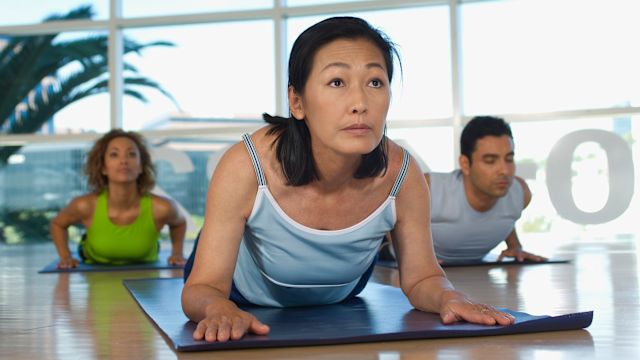When you’re suffering from exhaustion caused by rheumatoid arthritis (RA), the last thing you want to do is head to the gym. However, exercise may be just the thing your body needs to overcome fatigue if you have RA, according to a small study published in 2015. In fact, too much rest could be making your symptoms worse. Staying active may also relieve joint pain and stiffness, improve sleep, boost your mood, up your endurance and keep your heart and bones healthy. And studies show that it doesn’t worsen RA.
If you’re tired of being tired, these joint-friendly exercises might be just what you need to get off the couch and back on your feet.
Start with a Stretch
If you have rheumatoid arthritis, a good stretch will lengthen and strengthen the muscles surrounding stiff joints and improve your range of motion. Exercises that incorporate lots of stretches, such as Tai Chi, yoga and Pilates, are especially beneficial to people with RA. Try to do some stretching each day, working all the joints from your neck to your toes.
Take a Walk
Never underestimate the value of a good walk. It’s a low-impact exercise that’s easy on the joints. It can also be a fun way to work up a sweat with your friends. Just make sure to stay hydrated and wear the appropriate shoes. Ready to get started?
Add Water
If your joints can’t handle pounding the pavement or the treadmill, swimming is a great alternative. The water’s buoyancy supports your body’s weight as you swim, water walk or try other aquatic exercises. Swimming has also been shown to lower heart rate and improve blood pressure and circulation.
Lift Weights
It makes sense that strength training benefits people with RA. Building muscle around stiff, achy and weakened joints helps to protect them. You should try strengthening exercises, such as weight training, every other day (but if your joints are feeling particularly achy or swollen, take the day off). Resistance training isn’t just bodybuilding in the gym—using exercise bands, your own body weight or even soup cans also counts.
Remember the Small Stuff
Strength training, swimming and Tai Chi are great ways to target larger muscle groups, but when you have RA it is equally important to focus on the small stuff – your hands and fingers. Try these five moves to improve your range of motion and relieve stiff, achy joints in your hands.
Listen to Your Body
Talk to your rheumatologist or physical therapist before starting any fitness routine. Together, you can come up with a plan that is right for you and, hopefully, work up to 30 minutes of exercise five days a week. Remember that any movement, no matter how big or small, is beneficial to your health. If you can’t tolerate a full 30-minute exercise routine, break it up. RA sufferers, especially those suffering though fatigue, may benefit from several 10-minute exercises spread across the day. And, if you’re suffering through a flare, or in pain or discomfort, scale back or take a couple days off.
Medically reviewed in April 2020.





